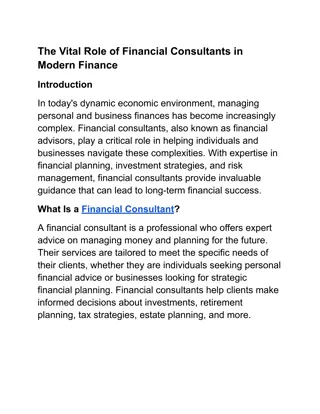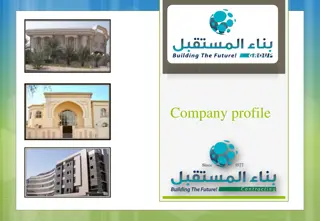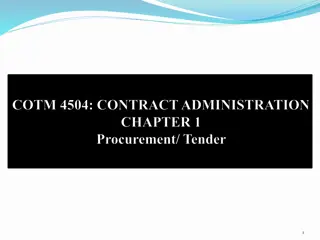Professional Consultants in the Construction Industry
The construction industry is a major sector encompassing general construction, specialty trade construction, and civil engineering construction. Professional consultants play vital roles in project success, such as architects designing buildings, site foremen organizing construction works, and quantity surveyors calculating and managing project costs. Clients, who finance projects, collaborate with these professionals to ensure successful construction endeavors.
Download Presentation

Please find below an Image/Link to download the presentation.
The content on the website is provided AS IS for your information and personal use only. It may not be sold, licensed, or shared on other websites without obtaining consent from the author. Download presentation by click this link. If you encounter any issues during the download, it is possible that the publisher has removed the file from their server.
E N D
Presentation Transcript
Module 1: Professional consultants INTRODUCTION Infrastructure is the product of one of the largest industries in the world: the construction industry. The construction industry can be divided into three main categories: general construction, speciality trade construction and civil engineering construction. In these categories, various professionals are responsible for a specific segment construction project. www.futuremanagers.com
Module 1: Professional consultants (continued) DUTIES AND RESPONSIBILITIES CLIENTS Clients are people for whom construction work is done. They take full financial responsibility for the project s success. The main responsibilities of the client include the following: Providing site surveys, and any additional knowledge, Working with the relevant authorities and governing bodies, Financing the project and authorising payments, and Selecting the required professionals and collaborating with contractors. www.futuremanagers.com
Module 1: Professional consultants (continued) DUTIES AND RESPONSIBILITIES ARCHITECTS Architects work for the construction industry and plan, design and oversee the construction of buildings and structures. Their main function is to design new buildings or extensions and alterations to existing buildings and other structures for an individual client or property developer, where they may also be responsible for the design of the surrounding landscape and space. Architects also provide advice on the restoration and conservation of old properties. www.futuremanagers.com
Module 1: Professional consultants (continued) DUTIES AND RESPONSIBILITIES SITE FOREMAN The site foreman, also called the construction foreman, is typically an experienced construction worker that fulfils the role of construction team leader on site. The main responsibility of the site foreman is to organise the construction works. www.futuremanagers.com
Module 1: Professional consultants (continued) DUTIES AND RESPONSIBILITIES QUANTITY SURVEYOR Once the design has been finalised and all the plans have been drawn up, the total cost of the project must be calculated. The architect appoints a quantity surveyor, who is responsible for the calculations that range from the initial estimates to the final purchase of the materials needed. The main purpose of the quantity surveyor is not only to calculate the cost of the project, but also to provide the client with value for money and play the role of negotiator, project coordinator and expense manager. www.futuremanagers.com
Module 1: Professional consultants (continued) DUTIES AND RESPONSIBILITIES STRUCTURAL ENGINEER Structural engineering is a subgroup of civil engineering. The structural engineer is appointed by the client and is responsible for the structural integrity of a construction project. This means that he/she gives advice on materials and structural members used to ensure that the structure can handle the loads that will be imposed on it. www.futuremanagers.com
Module 1: Professional consultants (continued) DUTIES AND RESPONSIBILITIES MECHANICAL ENGINEER The mechanical engineer is a jack of all trades and covers every aspect of the construction project, from the design phase right through to the selection of the material. Typically, any machinery used on the construction site falls under the mechanical engineer s responsibility. www.futuremanagers.com
Module 1: Professional consultants (continued) DUTIES AND RESPONSIBILITIES ELECTRICAL ENGINEER On the construction site, it is the electrical engineer s responsibility to manage and supervise all electrical work. Electrical engineers are responsible for the design, testing and installation of electrical systems for commercial, residential and industrial construction projects. www.futuremanagers.com
Module 1: Professional consultants (continued) DUTIES AND RESPONSIBILITIES BUILDING INSPECTOR Building inspectors are employed by the city council and conduct periodic site visits to ensure that contractors comply with: National building regulations, Zoning regulations, and Plan specifications. These inspections play a vital role in ensuring the safety of the contractors as well as the future occupants or users of the structure. www.futuremanagers.com
Module 1: Professional consultants (continued) DUTIES AND RESPONSIBILITIES CLERK OF WORKS The clerk of works is directly employed by the client or the architect and works between an office and construction sites. In instances where the clerk of works is employed by the client, he/she may monitor the architect during the design phase of a project. The main role of the clerk of works is to represent the interests of the client. This is accomplished through regular site visits. www.futuremanagers.com
Module 2: Building firm TYPES OF BUILDING FIRMS As each construction project is relatively unique, the type of approach and therefore the firm responsible for the work will differ. Projects can be divided into the following three groups based on their size: Small, Medium, and Large. www.futuremanagers.com
Module 2: Building firm (continued) DEPARTMENTS OF A BUILDING FIRM Each department in a building firm has its own set of responsibilities that contribute to the success of each project and, ultimately, the success and longevity of the construction firm itself. The organisational structure of each firm is different but common departments are the Contracts Department, the Costing Department, the Buying Department, Plant and Maintenance, and Human Resources. www.futuremanagers.com
Module 2: Building firm (continued) ACQUIRING BUSINESS The bigger a project, the more complicated it can be. The goal of each business owner is to grow his or her company. To do this, the company must complete project after project, slowly taking on larger and larger projects. The most common methods used to get business include: Recommendations and reputation, Advertising and digital media for marketing, and Tendering. www.futuremanagers.com
Module 3: Site preparation INTRODUCTION Planning and scheduling form a large and important part of managing a construction project. Planning and scheduling all the construction activities and possible pitfalls will lead to completing the project on time and within budget. A proper planning process includes site organisation, which covers site rules, traffic management, safety aspects and storage and waste management. www.futuremanagers.com
Module 3: Site preparation (continued) ORGANISATIONAL STRUCTURES ON A BUILDING SITE CONTRACT MANAGER As the title suggests, the responsibility of the contracts manager is to manage all the contracts related to the specific construction project. Contract managers are responsible for every phase of a contract s life cycle, when it is drafted, negotiated and signed. This also includes all other legal documents that are required for the respective project. This means that they must be highly detail-oriented and organised. www.futuremanagers.com
Module 3: Site preparation (continued) ORGANISATIONAL STRUCTURES ON A BUILDING SITE GENERAL FOREMAN The general foreman or site foreman is the person that is directly in charge of the construction site. This person performs similar duties to that of the project manager when it comes to the project site but follows a more hands-on approach. Where the project manager might work from an office or on-site, the general foreman is always on site. From here the project progress can be directly monitored and problems solved as they arise. www.futuremanagers.com
Module 3: Site preparation (continued) ORGANISATIONAL STRUCTURES ON A BUILDING SITE TRADES FOREMAN The trades foreman is responsible for managing workers, usually artisans, in their specific trade. The trades foreman is usually a very experienced worker in a specific trade and is responsible for the smooth running of the relevant trade activities. The trades foreman reports to the general foreman on work progress and any problems that may arise. www.futuremanagers.com
Module 3: Site preparation (continued) ORGANISATIONAL STRUCTURES ON A BUILDING SITE ARTISANS Artisans are workers that are trained in a specific trade, such as plumbing, welding and carpentry. They are normally subcontractors or form part of the subcontractor s team. Although artisans only focus on a specific job at hand, they contribute to the overall project progress. www.futuremanagers.com
Module 3: Site preparation (continued) ORGANISATIONAL STRUCTURES ON A BUILDING SITE LABOURERS Labourers on a construction site are normally people that are responsible for the supportive tasks. These tasks ensure that the construction process runs smoothly. www.futuremanagers.com
Module 3: Site preparation (continued) ORGANISATIONAL STRUCTURES ON A BUILDING SITE OPERATORS Heavy machinery is often use on large construction sites. The staff responsible for operating the machinery are called operators. They normally form part of a larger construction team. www.futuremanagers.com
Module 3: Site preparation (continued) ORGANISATIONAL STRUCTURES ON A BUILDING SITE SUBCONTRACTORS The subcontractor usually comes in the form of a company hired to conduct specific works, which normally requires specialised knowledge or tools. Subcontractors may include electricians, plumbers, structural engineers, glazing companies or any other discipline that the main contractor has to outsource. The subcontractors work with the general foreman and project manager. www.futuremanagers.com
Module 3: Site preparation (continued) ORGANISATIONAL STRUCTURES ON A BUILDING SITE STOREKEEPER A storekeeper is the person working in the storage facility on large construction sites. www.futuremanagers.com
Module 3: Site preparation (continued) ORGANISATIONAL STRUCTURES ON A BUILDING SITE GATE WATCHMAN The gate watchman is responsible for guarding the construction site. This is accomplished by monitoring the people entering and leaving the site. In addition to looking out for trespassers during construction and after hours, they also keep a look out for any potential dangers such as fire or water that may damage the construction site. www.futuremanagers.com
Module 3: Site preparation (continued) SITE PREPARATION Site preparation consists of multiple activities to transform an unfriendly site into an acceptable state for construction to start. This includes road access, security, site clearance, drainage, supplying utilities, and soil testing. www.futuremanagers.com
Module 3: Site preparation (continued) SITE LAYOUT Construction sites are inherently extremely busy, which makes the proper management thereof very important. One of the tools used by construction management to manage the layout of a site is a site layout plan. A site layout plan is a scaled graphic representation of the site that shows all the existing structures and landscaping. This plan is used to determine the best possible placement locations for materials and equipment and the movement routes of the workers on site. www.futuremanagers.com
Module 3: Site preparation (continued) REGULATIONS The National Building Regulations are standards that act as practical guidelines for anyone who wants to build a structure. They are put in place to ensure the health and safety of everyone working on, in and around the structure. www.futuremanagers.com
Module 4: Planning and programming PLANNING A construction project can be defined as a series of related tasks that are completed in a certain order. Any project can therefore be broken down into small, related tasks with small projects having less tasks to complete. To limit problems and work as efficiently as possible, you need to do proper planning. As the saying goes, Fail to plan, plan to fail . www.futuremanagers.com
Module 4: Planning and programming (continued) GANTT CHARTS A Gantt chart is a type of bar chart that provides a project overview to the stakeholders. Project information conveyed by the Gantt chart includes the following: Task list, and task start and finish dates, Duration of the tasks, Project milestone dates, and Project start and finish dates. www.futuremanagers.com
Module 5: Building materials ORDERING Without building materials, the act of construction is not possible. So, if the required material runs out during the project, it may cause a major delay and drive up costs. The material flow process from the supplier to where it will be used on site consists of the following main steps: Procurement, Storage, and Use. www.futuremanagers.com
Module 5: Building materials (continued) DOCUMENTATION the procurement of building materials is an important process. Keeping track of the building materials as they move through the process is equally important. The support system for the procurement process is documentation. From the point where material is requested until it is received, there is a document recording the transaction. www.futuremanagers.com
Module 5: Building materials (continued) WASTAGE One of the biggest problems facing the construction industry today is material wastage. As building materials tend to be relatively expensive, limiting the waste thereof would be considered good management. Doing this may not only lead to an increase in profits, but may also make the firm more competitive in obtaining business contracts. To effectively limit the materials wasted on a construction site, you need a proper waste management plan. www.futuremanagers.com
Module 6: Construction equipment SCAFFOLDING Scaffolding or a scaffold is a temporary structure that is erected to provide workers with a platform when working at heights. A scaffolding structure consists of various piping parts that each fulfil a specific role. The three main parts that make up the frame of the scaffold structure are the following: Standards, Ledgers, and Transoms. www.futuremanagers.com
Module 6: Construction equipment (continued) EQUIPMENT AND MACHINERY Equipment and machinery play an important role in project efficiency, work safety and the quality of the end product. The different machines and equipment used on construction projects includes: Hoisting equipment, such as pulleys and sheaves, Excavation equipment, such as excavators and backhoes, Levelling equipment, such as graders and bulldozers, and Compacting equipment, such as rammers, and smooth wheel rollers. www.futuremanagers.com
Module 7: Foundations FUNCTIONS OF A FOUNDATION Foundations are the legs of a building and without strong foundations, a building is sure to crack or even collapse at some point. Any mistake made in the construction of the foundation is amplified as you progress with the building of the structure. www.futuremanagers.com
Module 7: Foundations (continued) TYPES OF FOUNDATIONS Foundations can be divided into the following two main groups: Shallow foundations which have a relatively shallow depth that is usually no more than 3 m deep, and Deep foundations which have a depth of more than 3 m and are more complex and therefore more expensive than shallow foundations. www.futuremanagers.com
Module 7: Foundations (continued) SOIL CONDITIONS Soil conditions play an important role in the choice and construction of foundations. The soil layers consist of a mixture of tiny grains of rock, minerals, water, air and organic matter. Soils can be divided into the following three groups: Expansive soils, Collapsible soils, and Erodible soils. www.futuremanagers.com
Module 8 : Organisations in the construction industry ORGANISATIONS There are various professionals and companies involved in construction projects responsible for taking what is designed on paper and making it a reality. These companies consist of various people and professionals with the necessary skills and knowledge that enable them to realise their goals. Although construction companies might differ based on their size or the type of work they do, they are all some form of legal entity. www.futuremanagers.com























